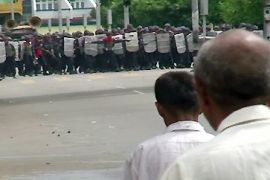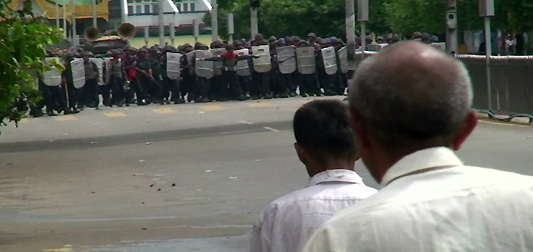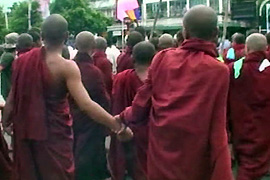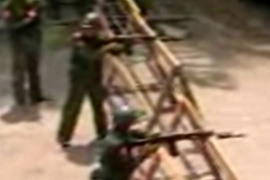Yangon marchers ‘not afraid to die’
As the crackdown continues, Al Jazeera’s correspondent reports from inside Myanmar.

 |
| The military crackdown in Myanmar has claimed an uknown number of lives |
He had a craggy face, a limp, he was 60 years of age and had a resolve that underlined Myanmar’s new drive for democracy.
“I am not afraid to die,” he told me in halting English. “They will only kill flesh and bones. Spirit cannot be destroyed, so in the end we will win.”
| IN VIDEO | |
|
|
Then he walked to the head of several thousand protesters in central Yangon and advanced towards the waiting soldiers, stern faced, fingers on the triggers of their weapons.
He raised his hand and stood there in a gesture of defiance.
It met with applause from the protesters and people who watched the unfolding drama from their windows and balconies.
The soldiers did nothing – but it was only temporary. Minutes later they acted.
Two army units closed both ends of the street in a pincer movement that trapped hundreds of civilians.
They poured out of their trucks, with guns and batons. Men in civilian clothes joined them with large bamboo sticks.
They waded into the protesters, beating and slashing. I saw people on the ground being beaten and pounded and kicked, blood pouring from head wounds.
Others were dragged off to a row of waiting buses.
Soldiers grabbed me. “Tourist!” I explained. They didn’t believe me.
 |
| Monks have been at the forefront of protests for several days |
I was pushed and jostled. They grabbed my camera which I’d used to film some of the scenes.
“Give me the tape,” an officer demanded. A little man with a bamboo stick poked me sharply in the back.
“No tape, I didn’t film!” I lied. I showed them a tourist guidebook as if in explanation.
Two other protesters were dragged past me, one had blood all over his face.
A solider made a report to the officer and they turned to where the main area of attack was.
I saw an opportunity and ran. It was a lucky escape.
A few hours later, I heard of the Japanese photographer having been shot for taking images of the army action.
Up until Thursday, monks had been leading the protests, raising Buddhist flags in the air they galvanised public feeling.
Clampdown accelerating
They chanted mantras and stood in front of the armed soldiers praying and calling for peace.
But the army used the night-time curfew to arrest thousands of monks.
| Myanmar protests |
Something like 2,000 are said to have been taken, along with intellectuals and other public figures including poets and actors.
It’s rumoured that many are being held at the race course in the city, but it is impossible to get near there.
Now the military clampdown is accelerating. Soldiers now stand guard at all the hospitals in the city and a makeshift mortuary is said to have been set up.
On Friday state television announced that nine protesters have been killed and 11 injured.
Defiance
The announcer also said that nearly 40 soldiers had been injured. I hadn’t seen one who had been hurt.
In Yangon, civilians have been risking their lives on a daily basis challenging the soldiers.
|
“The largely Buddhist population does revere their monks and they will not sit by idly while they are being beaten up” Kraut, Hamburg, Germany |
The military government has imposed a curfew and banned gatherings of more than five people.
Throughout Yangon and other cities throughout Myanmar, people blatantly defy that in scenes which have not been seen here for nearly 20 years.
By early Friday – two days after the government began its crackdown – students, in the absence of the monks, had stepped in to lead the protests.
Numerous gatherings spread around the city centre. But the army was out in force.
“Dangerous!” some young men told me, and they made a firing gesture. “You must go.”
But go where? Wherever you went, whichever road or back alley you took at the end of it were soldiers.
Panic
The crack of shots echoed through the buildings and people panicked running away or pushing into doorways.
There was no explanation as to why they were firing on most of the occasions.
Filming the protests, I spoke into my camera: “I don’t know why they are firing,” I said, “but I am not waiting around to find out.”
I later discovered that in the panic I had not pressed the record button.
The soldiers pushed the demonstrators further back and further out.
Far more shots were fired by the army on Friday than any other day.
I saw at least one young man in the distance fall, apparently because he was wounded.
He got up and managed to get away. Volleys of shots rang out over our heads at least four times.
Restrained
So far, compared to the mass killings of 1988 when more than 3,000 people were killed, the army has been more restrained.
 |
| The future of Myanmar lies with decisions taken by Myanmar’s military |
Part of that is due to the fact that unlike 1988 there has not been any looting or burning of cars and buildings giving the military an excuse to take an even tougher hand.
On Friday a few of the protesters smashed police traffic cabins, some threw stones and others used catapults, but they were quickly stopped by other older protesters.
“We want to have peaceful demonstrations,” one man explained to me. “We just want our rights, democracy. Please tell the world.”
The world now knows. But the fact is that, apart from yet more sanctions, the world can do nothing to make a violent military dictatorship change its mind.
Even though people like the defiant old man who faced the military with his hand raised think that, eventually, they will.

